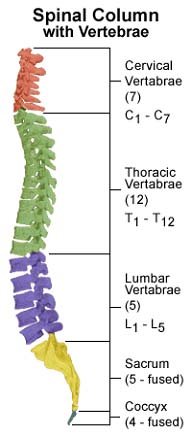The Spinal Column
Following on from last months column about bones, this month I thought I’d discuss some interesting facts about the spine. The spinal column has 3 very important functions. It supports the body’s weight, provides flexibility for movement and protects the spinal cord and the nerve roots from damage. As babies, we are born with 33 bones in our spine (vertebrae) but as adults we end up with 26. Four fuse to make our tailbone (coccyx) and five fuse to make the back of the pelvis (sacrum). The first vertebrae in our spine is called the Atlas. Atlas is a character from Greek mythology who, after losing a fight, was turned to stone and had to carry the weight of the Earth on his shoulders. This vertebrae were given his name as it carries the entire weight of the head. Around one quarter of the spine’s length is made up of fibrocartilage, this is due to presence of the intervertebral discs, which act as shock absorbers between our vertebrae. These discs expand in the absence of gravity, so as a result astronauts returning from space may be 1.5 to 2 inches taller than when they left. Gravity’s effect on these discs is also the cause of humans shrinking between a quarter to half an inch every decade after the age of 40. It also why we are generally taller in the morning than at night because of the daily effect of gravity upon the body. Four out of five adults will experience some type of spinal pain during their lifetime. Lower back pain is the most common type of spinal pain experienced. This is because the lower spine twists and bends more than any other part of our spine, it also bears the weight of our upper body. Sometimes back pain can be caused by other ailments in the body. Pain experienced in the middle of the back, which becomes worse after eating, may be a sign you have a stomach ulcer. And if you experience an intermittent back pain that reaches your groin, it could indicate you have kidney stones.
